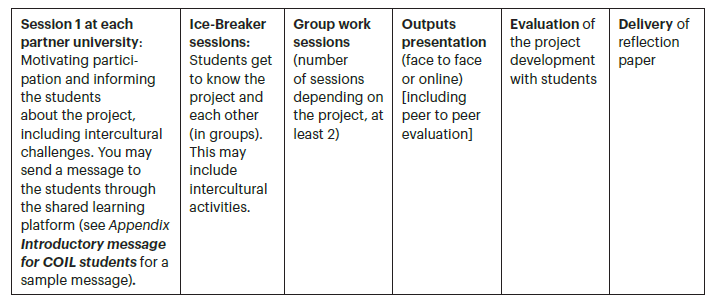Here are some guidelines for setting up a Collaborative Online International Learning project. These guidelines are especially useful for UVic staff interested in virtual exchange, but they may also be inspiring for our partners. They include references with resources.
WORK STEPS
Contact your international relations coordinator (CARI at Uvic-UCC) to tell him or her about your interest in COIL. Your international coordinator will help you search for an existing project at a partner university that fits. Alternatively, you can develop an idea and project overview yourself (COIL project proposal, see examples here).
• Contact potential partners at foreign universities or alternatively answer a request from a foreign university.
• Hold one or two meetings with the future partners’ professors with two aims:
– on the one hand to get to know each other, share doubts and previous experiences and
– on the other hand to make a decision and develop a work plan in order to establish a final written proposal of the project.
These previous meetings are extremely important so that a joint workflow emerges and synergies are developed.
• Ask for faculty approval, which in the case of UVIC will be managed by the CARI by submitting the COIL project proposal.
• Train, if needed, in COIL and intercultural competences, at your home university. Contact your Teaching Support Unit (UDUTE or CIFE at UVIC-UCC) to suggest training courses in these areas.
• Participate in initial orientation and experience exchange sessions organized by your international coordinators (CARIs at Uvic-UCC).
Once both lecturers or lecturer teams decide to go ahead with the project, there are some preliminary steps to be carried out before beginning the project design. We recommend exchanging basic information about:
• The course in the context of the whole academic system, the degree [contextual frame] and competences
• Academic calendar
• General assessment criteria and dates at each university
• Description of the contents and learning activities in the course
• Student profile involved (number, L1, prior subject knowledge, level of cultural awareness, special needs…). If there is a considerable difference in the number of students involved, you may consider groups in both universities with a different number of students but with an equal number of speakers (speakers may also rotate).
When you have reached an agreement on all these basics, time for designing the COIL project in collaboration with your partner(s) begins. We recommend following these next steps and establishing:
• the topic and the goals of the project
• timing and schedule (see proposal here)

• How to monitor progress in students’ teamwork
• Expected project outputs
• Assessment criteria
• Digital tools and resources – during this phase we recommend clarifying, with the support of the University Teaching and Educational Technology Unit (UDUTE) and ICT Unit, which learning environment students will share, how they will access it, how they will ask for technical help.
• Details of students’ work steps and work space design
• Lecturers put students into groups and share work steps and access to the learning platform.
• Lecturers monitor students’ teamwork.
• Lecturers at both institutions stay in contact throughout the duration of the project to avoid misunderstandings, solve problems that arise and deal with any unforeseen issues.
• Students work together and participate in the group work sessions.
• Students present their outputs. Best outputs may be selected and published on the learning platform or a blog.
• Students complete a course satisfaction questionnaire provided online by Uvic-UCC Quality Unit.
• UVic-UCC provides student and teacher recognition.
• A two-level debriefing phase is recommended to provide feedback to solve problems, suggest new lines of action and boost innovation and improvement:
– First among professors sharing the activity, where teacher and student feedback will be discussed and suggestions for improvements made.
– Later, peers involved in independent COIL projects will share their (positive and negative) experiences and discuss further recommendations. This second level should be fostered by CARIs at the end of the academic year.
• Joint presentation of papers or publishing may be discussed.





